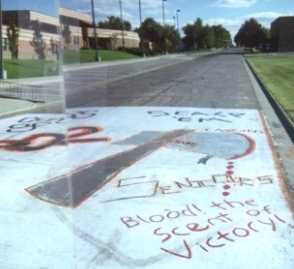 Another Stereotype of the Month entry:
Another Stereotype of the Month entry:
 Another Stereotype of the Month entry:
Another Stereotype of the Month entry:
By Barbara Taormina/northshore@cnc.com
Friday, March 09, 2007 — Updated: 12:58 PM EST
The town of Saugus didn't set out to become a frontline in the battle of what is and isn't politically correct — it just sort of happened that way.
Last week, as people in town were chewing over the charge that their much-loved Sachem logo was "outdated" and demeaning to Native Americans, a local event came under fire for it's alleged insensitivity.
Last Saturday, the Friends of Breakheart Reservation in Saugus hosted a day of Native American culture that included an exhibit of artifacts, cooking demonstrations and story telling. And for the kids, there was an arts and crafts table where they could make fake tomahawks and then test them by throwing them at a target.
Peter Sanfacon, who heads up the New England Anti-Mascot Coalition that is now urging cities and towns to get rid of Native American logos and mascots used for sports teams, read about the event in the Saugus Advertiser. Sanfacon wrote to Ed Murray, chairman of the board of the Friends of Breakheart, asking him to rethink the tomahawks.
"I respectfully ask that you reconsider this activity, which is simply perpetuating the offensive stereotype that all native people were violent and wielded tomahawks," wrote Sanfacon.
That piece of advice didn't sit well with Murray, who says the tomahawk table was added in so that kids could have some fun and keep busy while their parents were enjoying other events. He was also upset that all of the other carefully planned demonstrations and exhibits that paid tribute to local Native Americans were completely overshadowed by an activity for kids.
As for the tomahawks being fake, Murray, an amateur historian who has put in a lot of time studying local records, made no apologies.
"Do you think there might be a faint possibility that young Native Americans practiced with 'fake tomahawks,' or were they just allowed to wail at one another with the real thing?" he asks Sanfracon in an e-mail exchange.
A lot of people will probably find it hard to call exactly who wins here. On one side is Murray, who wants people to learn more about Native American cultures and tries to do that by making local history fun and accessible. On the other side is Sanfacon, who wants desperately to correct centuries of injustice for Native Americans, one arts and crafts table at a time.
Sanfacon isn't concerned with the historical accuracy of the tomahawks; he just feels it's not a part of the past that we should highlight.
"Teaching white suburban kids how to make tomahawks isn't anything useful," says Sanfacon.
Maybe, and maybe not. Granted, white suburban kids are more familiar with Glocks, tasers and pepper spray, but tomahawks must have an appeal. And aren't they part of archeological record left behind by Native American?
Murray insists that you can't change history, and all cultures have tools and weaponry. To think that Native Americans didn't is a little unrealistic. They needed tomahawks — they lived in the woods with lots of natural predators, including crowds of white settlers who were doing their best to kill them and steal their land. There should have been a tomahawk factory — maybe things would have worked out differently.
But they didn't, and what we are left with now is two people who essentially want the same thing — a deeper respect and a broader understanding of Native American culture — battling it out in Saugus, where the Native American population is approximately .2 percent.
Bruce Curliss, a former head of the Massachusetts Commission on Indians Affairs, has suggested the best way to deal with these problems is to get everyone to the table to talk about it rationally. That seems to be something both Murrary and Sanfracon would probably go for.
As Murray half-jokingly puts it, "Can't we all just get along?
Rob's comment
Making and throwing tomahawks is stereotypical, of course. It doesn't matter if they're part of the "archaeological record." What matters is how often non-Indians have used tomahawks to characterize Indians, and whether one more example of this tells us anything useful.
Will kids learn something they haven't already learned from countless illustrations, movies, cartoons, sports mascots, and product packages? Probably not. Will they learn something misleading: that all Indians, not just the local Indians, engaged in warfare with tomahawks? Probably. Therefore, Sanfacon has the winning arguments in this debate.
Note: The picture doesn't come from the Saugus event, but it shows what people are thinking when they link Indians and tomahawks.
Related links
Indian wannabes and imitators
YMCA-Indian Guides
|
. . . |

|
All material © copyright its original owners, except where noted.
Original text and pictures © copyright 2007 by Robert Schmidt.
Copyrighted material is posted under the Fair Use provision of the Copyright Act,
which allows copying for nonprofit educational uses including criticism and commentary.
Comments sent to the publisher become the property of Blue Corn Comics
and may be used in other postings without permission.